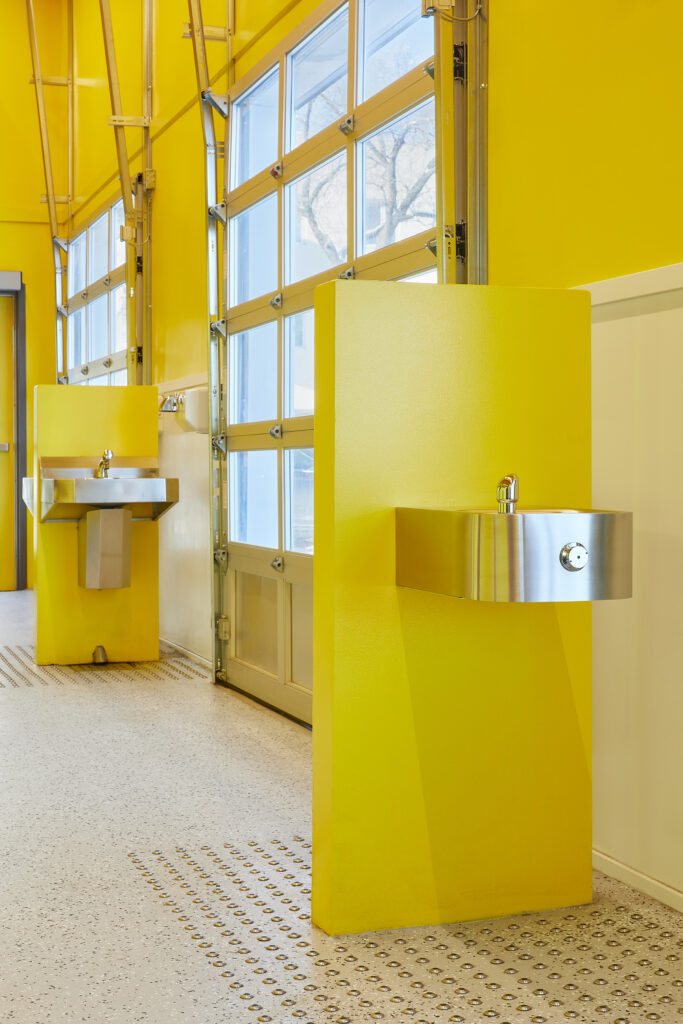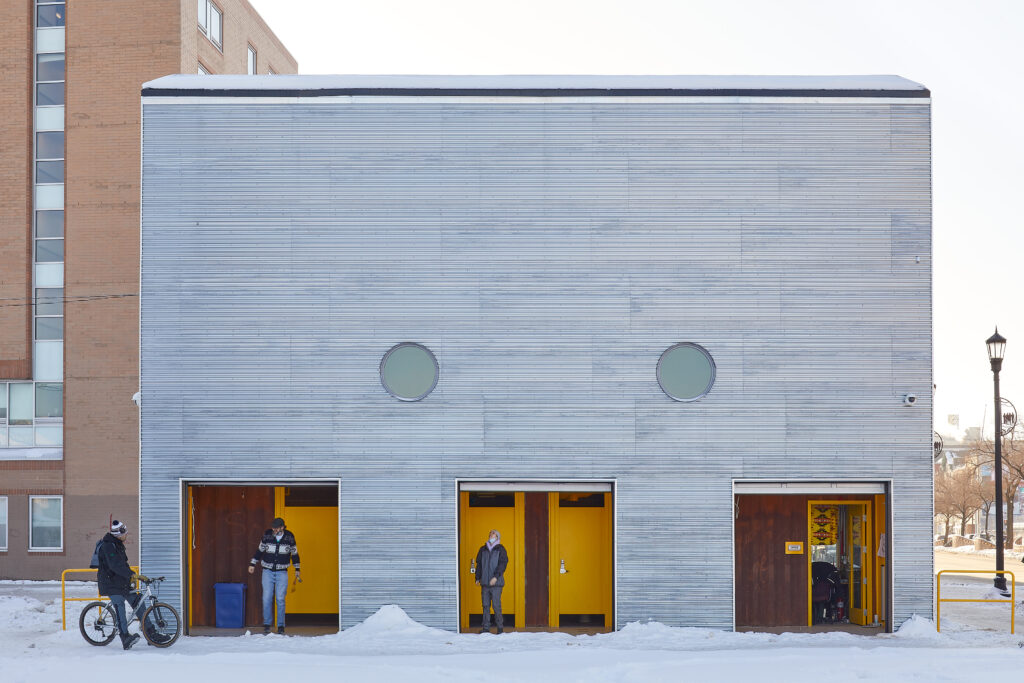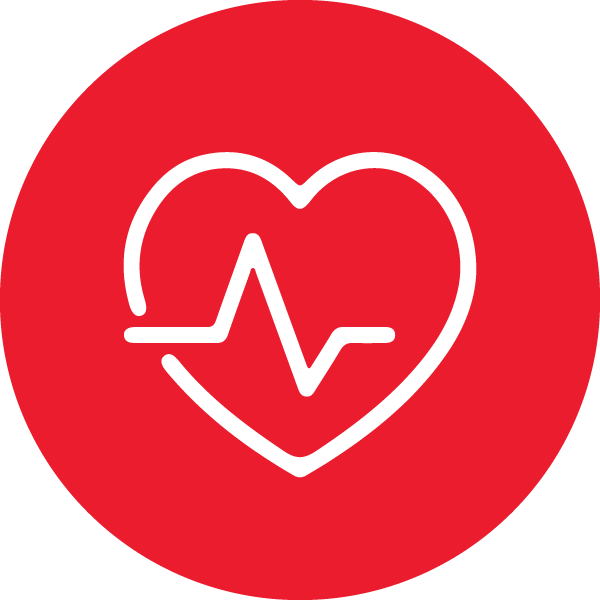New four-year funding secured for the facility
Amoowigamig provides dignity and equity to a community that lives and gathers downtown. At its core, the facility provides essential amenities such as toilets, handwashing stations, and clean drinking water to those with few or no alternatives.
“It means everything to them. It’s a safe, secure place that they can come and just use the washroom, which is something a lot of people take for granted,” says Jacob Kaufman, Amoowigamig’s team lead.
Since opening its doors last June, more than 25,000 people have visited Amoowigamig, which means public washroom in Ojibwe. “Being a washroom is a small part of what we do here, we have harm reduction supplies, so needles, crack pipes, condoms, lube, hygiene products, pads, tampons, things like that,” Kaufman says.

Harm reduction is an essential aspect of what Amoowigamig offers community. The facility is staffed with peer support workers who provide access to life saving supplies, such as naloxone, clean drug paraphernalia, and safer sex supplies, and who connect people with community and agency resources.
Throughout initial community consultations, on-site staffing was recognized as critical to the project’s success and the overall safety of facility users and the building itself.
Melissa Stone, a project coordinator for Astum Api Niikinaahk and Amoowigamig, says the “peer support workers have been unsheltered at some point in their life. They get it – relationships are easily built with community and community really likes them.”
“I grew up homeless. I grew up in Vancouver. So, when they started handing out essentials like needles and crack pipes, we saw a massive decrease in the rate of HIV, hepatitis, and AIDS on Hastings Street,” Kaufman says. “A common misconception about harm reduction is that it enables people to use drugs, but the truth is that it enables them to use drugs safely. This [Amoowigamig] is in no way, shape, or form a safe injection site, but it is a bathroom, and we know people are going to do things in there.”
The three-story re-purposed shipping container features one accessible washroom, three general use stalls, and two outdoor urinals located at the rear of the facility with privacy doors. Wins Bridgman, the architect behind the project, says his focus was on safety. Bridgman explains that community members wanted to have a space to go that felt safe, “where my friends can see and hear me.” The stalls have half doors, so staff members can see if they need to respond to a medical emergency, which has “helped us save lives,” says Kaufman.



Each indoor stall is equipped with a bio-bin for used needles that could otherwise end up on sidewalks and in public spaces. The stalls also come equipped with panic buttons, which set off an alarm in the peer support office. Each stall has individual lights that dim when someone has been in the stall for more than five minutes, which is a safety feature.
“We gently knock on the door [when the lights dim] to make sure someone hasn’t overdosed and isn’t in distress,” explains Kaufman. “I’ve lost count of how many people we’ve helped. We’ve had countless medical emergencies here and done Narcan reversals. So, when someone overdoses on fentanyl or another opioid, we reverse it with Narcan, and it’s been incredible.”
“Harm reduction just isn’t about drugs. It’s about necessities and human rights for individuals,” says Stone. Amoowigamig has become a destination and community hub for residents and visitors of the downtown neighbourhood. Ma Mawi reports staff routinely and successfully assist facility visitors with Employment and Income Assistance, Legal Aid, finding a family doctor, navigating challenges with Child and Family Services, and securing shelter openings. “Harm reduction is finding a place to lay your head in a shelter if you can’t afford rent,” Stone says.
The Amoowigamig support team is able to make calls or send emails advocating and offering support for individuals with a variety of needs: “if people are looking for food, we tell them where they can go, if they are looking for a doctor, we tell them where to go, if someone needs to connect with the police on a current matter, we connect them,” explains Kaufman. Peer support staff have personally secured housing for 30 previously unsheltered individuals since the project’s launch.
Amoowigamig is located on the corner of Main Street and Henry Avenue. The project cost $925,000 to build with funding from the Canadian Medical Foundation and the Canada Healthy Community Initiatives fund, a program administered by The Winnipeg Foundation, which granted the project $250,000.

The facility has been treated with respect, says Kaufman, noting “there’s no graffiti, there’s no smashed windows, there’s no garbage. It is clean. It is beautiful and that is mainly because the community wants it to be kept in the shape it is because it means so much to them for a litany of different reasons.”
Maintaining the surrounding area is an essential aspect of the project, and The Winnipeg Foundation has
provided $230,000 for hardscaping, site furnishings, lights, cultural markers, and Indigenous gardens. Brook McIlroy, an Indigenous landscape company, has consulted extensively with local organizations and community members, and designed a plan based on traditional Indigenous knowledge. Work on the grounds will get underway this summer.
The facility is currently open seven days a week for 10 hours a day. A reduction in hours was forecast due to a lack of secured funding, but a recent additional grant from The Foundation to Ma Mawi Chi Itata for $225,000 per year until 2026, will help the facility continue providing community care for at least eight hours per day.



 Health, Wellness & Recreation
Health, Wellness & Recreation